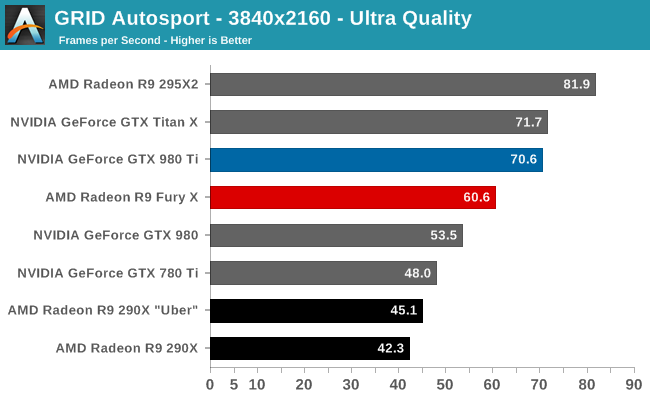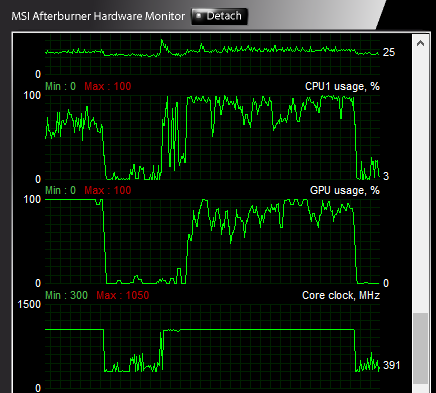The AMD Radeon R9 Fury X Review: Aiming For the Top
by Ryan Smith on July 2, 2015 11:15 AM ESTGRID Autosport
For the racing game in our benchmark suite we have Codemasters’ GRID Autosport. Codemasters continues to set the bar for graphical fidelity in racing games, delivering realistic looking environments with layed with additional graphical effects. Based on their in-house EGO engine, GRID Autosport includes a DirectCompute based advanced lighting system in its highest quality settings, which incurs a significant performance penalty on lower-end cards but does a good job of emulating more realistic lighting within the game world.


Unfortunately for AMD, after a streak of wins and ties for AMD, things start going off the rails with GRID, very off the rails.
At 4K Ultra this is AMD’s single biggest 4K performance deficit; the card trails the GTX 980 Ti by 14%. The good news is that in the process the card cracks 60fps, so framerates are solid on an absolute basis, though there are still going to be some frames below 60fps for racing purists to contend with.
Where things get really bad is at 1440p, in a situation we have never seen before in a high-end AMD video card review. The R9 Fury X gets pummeled here, trailing the GTX 980 Ti by 30%, and even falling behind the GTX 980 and GTX 780 Ti. The reason it’s getting pummeled is because the R9 Fury X is CPU bottlenecked here; no matter what resolution we pick, the R9 Fury X can’t spit out more than about 82fps here at Ultra quality.
With GPU performance outgrowing CPU performance year after year, this is something that was due to happen sooner or later, and is a big reason that low-level APIs are about to come into the fold. And if it was going to happen anywhere, it would happen with a flagship level video card. Still, with an overclocked Core i7-4960X driving our testbed, this is also one of the most powerful systems available with respect to CPU performance, so AMD’s drivers are burning an incredible amount of CPU time here.
Ultimately GRID serves to cement our concerns about AMD’s performance at 1440p, as it’s very possible that this is the tip of the iceberg. DirectX 11 will go away eventually, but it will still take some time. In the meantime there are a number of 1440p gamers out there, especially with R9 Fury X otherwise being such a good fit for high frame rate 1440p gaming. Perhaps the biggest issue here is that this makes it very hard to justify pairing 1440p 144Hz monitors with AMD’s GPUs, as although 82.6fps is fine for a 60Hz monitor, these CPU issues are making it hard for AMD to deliver framerates more suitable/desirable for those high performance monitors.











458 Comments
View All Comments
chizow - Thursday, July 2, 2015 - link
What about geometry Ryan? ROPs are often used interchangeably with Geometry/Set-up engine, there is definitely something going on with Fury X at lower resolutions, in instances where SP performance is no problem, it just can't draw/fill pixels fast enough and performs VERY similarly to previous gen or weaker cards (290X/390X and 980). TechReport actually has quite a few theoreticals that show this, where their pixel fill is way behind GM200 and much closer to Hawaii/GM204.extide - Thursday, July 2, 2015 - link
Yeah my bet is on Geometry. Check out the Synthetics page. It own the Pixel and Texel fillrate tests, but loses on the Tessellation test which has a large dependency on geometry. nVidia has also been historically very strong with geometry.CajunArson - Thursday, July 2, 2015 - link
Thanks for the review! While the conclusions aren't really any different than all the other reputable review sites on the Interwebs, you were very thorough and brought an interesting perspective to the table too. Better late than never!NikosD - Thursday, July 2, 2015 - link
You must use the latest nightly build of LAV filters, in order to be able to use the 4K H.264 DXVA decoder of AMD cards.All previous builds fall back to SW mode.
tynopik - Thursday, July 2, 2015 - link
"today’s launch of the Fiji GPU"andychow - Thursday, July 2, 2015 - link
Best review ever. Worth the wait. Get sick more often!tynopik - Thursday, July 2, 2015 - link
pg 2 - compression taking palcelimitedaccess - Thursday, July 2, 2015 - link
Ryan, regarding Mantle performance back in the R9 285 review (http://www.anandtech.com/show/8460/amd-radeon-r9-2... you wrote that AMD stated the issue with performance regression was that developers had not yet optimized for Tonga's newer architecture. While here you state that the performance regression is due to AMD having not optimized on the driver side. What is the actual case? What is the actual weighting given these three categories? -Hardware Driver
API
Software/Game
What I'm wondering is if we make an assumption that upcoming low level APIs will have similar behavior as Mantle what will happen going forward as more GPU architectures are introduced and newer games are introduced? If the onus shifts especially heavily towards the software side it it seems more realistic in practice that developers will have much more narrower scope in which optimize for.
I'm wondering if Anandtech could possibly look more indept into this issue as to how it pertains to the move towards low level APIs used in the future as it could have large implications in terms of the software/hardware support relationship going forward.
Ryan Smith - Thursday, July 2, 2015 - link
"What is the actual case? What is the actual weighting given these three categories? -"Right now the ball appears to be solidly in AMD's court. They are taking responsibility for the poor performance of certain Mantle titles on R9 Fury X.
As it stands I hesitate to read into this too much for DX12/Vulkan. Those are going to be finalized, widely supported APIs, unlike Mantle which has gone from production to retirement in the span of just over a year.
limitedaccess - Thursday, July 2, 2015 - link
Thanks for the response. I guess we will see more for certain as time moves on.My concern is if lower level APIs require more architecture specific optimizations and the burden is shifted to developers in practice that will cause some rather "interesting" implications.
Also what would be of interest is how much of reviewers test suites will still look at DX11 performance as a possible fallback should this become a possible issue.